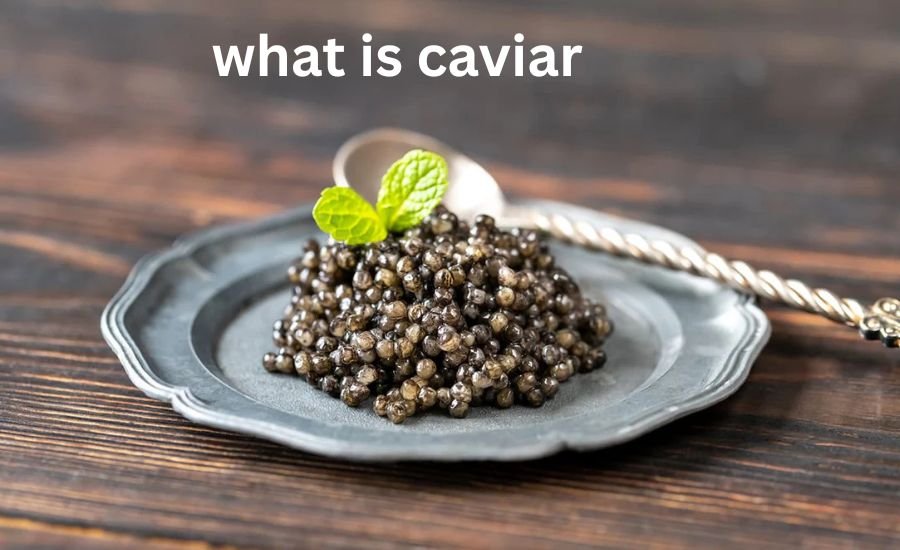Caviar is more than just a delicacy it’s a symbol of elegance, tradition, and gourmet taste. When someone asks what is caviar, they’re not just asking about food. They’re diving into centuries of culture, luxury, and culinary craft. This article takes a deep look at the origins, types, taste, health benefits, and the modern appeal of caviar. Whether you’re curious, a foodie, or an aspiring gourmet chef, we’ll help you fully understand caviar.
The Rich History Behind What is Caviar
To begin answering what is caviar, we must travel back in time. The word “caviar” comes from the Persian word “khav-yar,” meaning “cake of strength.” Ancient Persians believed that caviar had powerful healing properties. Even in those days, they knew what caviar was and valued it highly.
Russian and Persian royalty made caviar famous. They were among the first to turn it into a delicacy. From there, caviar made its way into the courts of Europe. By the 19th and 20th centuries, it became the highlight of high-class dinners in Europe and the United States.
Today, if someone asks you what caviar is, you can tell them it’s more than fish eggs, it’s history on a spoon.
Understanding What is Caviar: The Basics
So, what is caviar in the simplest terms? Caviar is the salted roe (eggs) of sturgeon, a fish found in the Caspian and Black Seas, and more recently, in controlled farms worldwide. These eggs are harvested carefully and processed to preserve their flavor and texture.
Not all fish eggs are caviar. True caviar only comes from sturgeon species such as Beluga, Osetra, and Sevruga. When people ask what caviar is, it’s important to note that salmon eggs or lumpfish roe may look similar, but they are technically not caviar.
Types of Caviar: What is Caviar in Varieties
To understand what is caviar, one must explore its different types:
Beluga Caviar
Known for its large, delicate eggs and buttery flavor, Beluga is the most luxurious form of caviar. If someone wonders caviar at its finest this is the answer.
Osetra Caviar
With medium-sized eggs and a nutty, rich taste, Osetra is a favorite among caviar lovers. Its golden hue makes it visually appealing as well.
Sevruga Caviar
Smaller eggs, but with a strong, salty taste. Sevruga is often more affordable but still offers a premium experience when defining what is caviar.
Each type has its own texture, color, and flavor, giving foodies many options to enjoy and explore what makes caviar so special.
Harvesting Process: How We Get What is Caviar
Ever wondered how we go from fish to this shiny delicacy on your plate? Understanding how caviar is harvested reveals its value.
The process begins with carefully raised sturgeon, often in clean, controlled environments. Farmers wait many years, sometimes up to 20 for a female sturgeon to mature. When ready, the roe is gently removed and passed through a sieve. It is then washed, salted, and packed into tins.
The method is traditional but evolving with modern techniques. Sustainable caviar farms have made it easier to answer what is caviar with a focus on ethics and environment.
What is Caviar’s Taste Like? A Gourmet Experience
Describing caviar in terms of taste is like explaining the taste of wine; it’s complex.
The flavor of caviar can range from salty and oceanic to nutty and buttery. True caviar bursts softly in the mouth, releasing a rich flavor that lingers. The texture and taste vary based on the fish species, water quality, and processing method.
If someone still wonders what caviar is, let them try it once. One spoonful can explain more than words ever could.
Nutritional Benefits: What is Caviar Good For?
Besides being a luxurious treat, caviar is good nutritionally?
Caviar is packed with:
- Omega-3 fatty acids (great for heart and brain health)
- Vitamin B12 (boosts energy)
- Selenium and Iron (support immunity and blood health)
- High-quality protein
Eating caviar in small portions can support your health while satisfying gourmet cravings. So, next time someone asks about caviar, you can say it’s both fancy and healthy.
Read More: Devil-happy-meal-mcdonalds-viral-trend
How to Serve and Eat Caviar Properly
Caviar is delicate and should be served with care. To truly answer caviar, one must understand the etiquette of enjoying it.
Traditionally, caviar is served:
- On a mother-of-pearl spoon (metal can alter its taste)
- Over ice to keep it fresh
- With blinis (tiny pancakes) or toast points
- Paired with crème fraîche or chopped onions
Avoid overpowering flavors. Let the caviar shine. To those who ask about caviar, it’s not just food, it’s an art.
Storing Caviar: What is Caviar’s Shelf Life?
Proper storage is crucial in preserving quality. Knowing caviar also means knowing how to keep it fresh.
Unopened, high-quality caviar can last in the refrigerator for up to 4 weeks. Once opened, consume it within 2-3 days. Always use clean, non-metallic utensils to avoid contamination.
Modern Trends: What is Caviar Today?
Caviar has evolved from being exclusive to aristocrats. Today, understanding what is caviar includes its role in modern food culture.
You’ll find caviar:
- On sushi rolls
- Topping deviled eggs
- In fine dining and even trendy cafes
- As part of luxury tasting menus
Chefs now use caviar creatively. Still, they respect its origin and keep its essence intact. So, when asking about caviar in today’s world, the answer is: traditional luxury meets modern style.
Caviar Substitutes: What is Caviar for the Budget Gourmet?
If real sturgeon caviar is too pricey, there are alternatives.
- Salmon roe (ikura)
- Trout roe
- Lumpfish caviar (dyed and flavored)
While these substitutes aren’t true caviar, they offer a similar texture and appeal. They’re good options for those curious about caviar without breaking the bank.
Features of Caviar – Easy Table
| Feature | Details |
| Main Ingredient | Fish eggs (mostly from sturgeon) |
| Color | Black, grey, golden, or even red |
| Taste | Salty, smooth, creamy, sometimes buttery |
| Smell | Very mild, like fresh sea breeze |
| Texture | Soft, delicate, tiny round pearls |
| Popular Types | Beluga, Osetra, Sevruga |
| Served With | Crackers, blinis (mini pancakes), toast, or eggs |
| Health Benefits | Full of vitamins, omega-3 fats, good for heart and brain |
| Luxury Level | Very high – used in fancy restaurants and celebrations |
| Storage | Must be kept cold, usually in the fridge |
| Shelf Life | Short – eat quickly after opening |
| Price Range | Can be very expensive (some are cheaper too) |
| Best Way to Eat | Chilled, with spoon or on bread/crackers |
| Fake vs Real | Real caviar comes from sturgeon only |
| Where It Comes From | Russia, Iran, USA, France, China, and farm-raised fish |
Caviar and Culture: What is Caviar Around the World?
Different countries view what is caviar in unique ways:
- Russia and Iran: Traditional leaders in caviar production.
- France: Known for fine preparation and pairing.
- USA and China: Rising in sustainable farmed caviar.
- Japan: Uses roe in sushi and fusion dishes.
Each culture adds a unique touch to what is caviar, expanding its meaning globally.
Caviar and Sustainability: What is Caviar’s Future?
Overfishing once endangered sturgeon, leading to strict controls. Now, aquaculture (fish farming) is helping.
Modern caviar farms focus on:
- Ethical harvesting
- Eco-friendly practices
- Maintaining fish populations
This means the answer to caviar now includes sustainability and responsibility. Enjoying caviar doesn’t have to harm the environment.
Caviar as a Symbol: What is Caviar in Pop Culture?
Caviar has appeared in movies, songs, and books as a sign of status. When a character orders caviar, it shows wealth, taste, or celebration. From James Bond parties to rap lyrics, what is caviar means more than food it’s a lifestyle.
Buying Guide: What is Caviar You Should Choose?
When buying caviar, check for:
- Freshness date
- Source (wild vs. farmed)
- Packaging (airtight tin or jar)
- Color, shine, and smell
Prices can vary greatly. Be sure you know what is caviar you’re getting, and always buy from trusted sellers.
Myths and Facts: What is Caviar Not?
Many people have misunderstandings:
- Myth: All fish eggs are caviar → Fact: Only sturgeon roe counts as caviar.
- Myth: Caviar is bad for you → Fact: It’s full of healthy fats and vitamins.
- Myth: Caviar must be fresh to be good → Fact: Properly cured caviar can last weeks.
Clearing these up helps define what is caviar in accurate terms.
Caviar Recipes: What is Caviar in the Kitchen?
You can use caviar in:
- Pasta dishes
- Omelets
- Sushi
- Tarts and canapés
Try this simple recipe: Caviar Toast: Toast a slice of baguette, spread butter or crème fraîche, and top with a small spoonful of caviar. It’s an elegant answer to caviar in your kitchen.
Benefits of Eating Caviar
✅ Good for Your Brain
Caviar has omega-3 fats that help your brain work better. It can help you think, focus, and even feel happier.
✅ Healthy Heart Support
Eating caviar in small amounts can be good for your heart. It helps keep your heart strong and your blood flowing well.
✅ Rich in Vitamins
Caviar is full of vitamins like A, D, E, and B12. These help your eyes, skin, and bones stay healthy.
✅ Gives You Energy
Caviar has protein that gives your body energy. It’s like a tiny power snack.
✅ Great for Skin and Hair
Some people say caviar helps your skin glow and your hair shine. That’s because of the healthy oils inside.
✅ Builds Strong Bones
It has vitamin D and calcium, which help make your bones and teeth strong and healthy.
✅ Boosts Your Mood
The healthy fats in caviar can help make you feel calm and happy. It’s like food for your feelings.
✅ Supports Your Immune System
Caviar helps your body fight off sickness. It makes your body stronger on the inside.
✅ Tiny But Powerful
Even a small spoon of caviar has many healthy things packed inside. You don’t need a lot to get the benefits.
✅ Good for Your Blood
It has iron, which helps your blood carry oxygen. That keeps you from feeling tired.
Caviar Experiences: What is Caviar for First-Timers?
If you’re trying caviar for the first time:
- Start with a small portion
- Pair it with champagne or dry white wine
- Keep flavors simple
You’ll understand firsthand what’ caviar’ is and why it’s so loved.
Luxury and Legacy: What is Caviar’s True Value?
Beyond the price tag, caviar represents craftsmanship, patience, and celebration. Each pearl of roe reflects years of care and tradition. That’s what makes it priceless to true connoisseurs.
Conclusion
So, now we all know what caviar is. It is not just fish eggs it is a special food that comes from a fish called sturgeon. People love to eat it at fancy dinners and big parties. It can taste a little salty, creamy, or even buttery. Caviar is also full of good stuff for your body like vitamins and healthy fats. You don’t need to eat a lot, just a little bit is enough to enjoy. Some people eat it with toast, others put it on tiny pancakes called blinis. There are also other kinds of fish eggs, but real caviar only comes from sturgeon. So next time someone asks you what caviar is, you can give them a big, smart answer.
Caviar is also cool because it has a long history from kings and queens to famous chefs. People around the world love it, and now farms help make it in a safe way that protects nature. That’s pretty awesome, right? You can even try it one day with just a small bite and see what the big deal is. Maybe you’ll like it, maybe not, but now you know the fun facts. Whether you’re a food lover, a curious kid, or just someone who likes learning new things, remember this: what is caviar is not just food it’s a fun, fancy adventure from the sea to your plate. Thanks for reading, and keep exploring yummy and interesting foods.
Do You Know: Sushi-bear-a-culinary-innovation-journey
FAQs
What is caviar made of?
Caviar is made of salt-cured fish eggs, mostly from a fish called sturgeon.
Is caviar healthy to eat?
Yes. Caviar has healthy fats, vitamins, and protein. It’s good for your brain, heart, and body.
How do you eat caviar?
Caviar is eaten cold, often on toast, crackers, or tiny pancakes called blinis.
Is caviar expensive?
Yes, real caviar can be very expensive because it’s rare and special. Some types are cheaper too.
Can kids eat caviar?
Yes, but only a little. It’s salty and strong, so small bites are best for kids.






